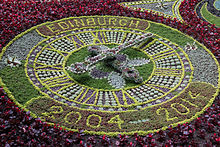Princes Street Gardens

The Princes Street Gardens are a public park in the center of the Scottish capital Edinburgh . You are at the foot of Edinburgh Castle . The park was created in the 1820s as a result of the long drainage of the Nor Loch and the construction of the New Town. Nor Loch was a large lake in the center of the city, which for centuries was polluted by the sewage flowing down from the higher lying Old Town.
Princes Street Gardens run south along Princes Street and are cut through by an artificial hill called The Mound . The eastern part ( East Princes Street Gardens ) runs from The Mound to Waverley Bridge and covers an area of 34,000 m². The larger western part of the park ( West Princes Street Gardens ) has an area of 120,000 m² and extends to the adjacent churches of St. John's and St. Cuthbert's near Lothian Road.
The park is a popular hangout in Edinburgh. Concerts at the Ross Concert Pavilion take place there regularly, especially during the Hogmanay celebrations.
Monuments
Within the park, along the south side of Princes Street, there are many statues and monuments. The most striking is the Scott Monument, built in 1844 in honor of Sir Walter Scott in Gothic style. In the eastern part there are also statues of the explorer David Livingstone , the publisher Adam Black and the writer and professor John Wilson. In the western part there are statues of the poet Allan Ramsay, the reformer Thomas Guthrie, the obstetrics pioneer James Young Simpson as well as the Scottish-American War Memorial, the Ross Fountain and concert pavilion and a popular flower clock .
The Ross fountain
The Ross fountain is an iron ornamental fountain from the 19th century. It is located at the western end of the park. The figures depicted on the fountain include water mermaids and four women who represent science, the arts, poetry and industry. Another female figure is at the top of the fountain.
The well was poured by the Durenne ironworks in the Haute-Marne department in the early 1860s . In 1862 the fountain was exhibited at the Great Exhibition in London. There it was discovered by the philanthropist and arms manufacturer Daniel Ross, who bought it for the city of Edinburgh. The fountain was transported in 122 individual parts and arrived in Leith (now part of Edinburgh) in 1869 .
Princes Street Gardens were carefully chosen as the location for the statue. It was erected in 1872. The fountain was a controversial issue at the time. For example, the dean of the neighboring St. John's Episcopal Church Edward Bannerman Ramsay described the fountain as "terribly indecent and disgusting".
Since a renovation in 2001, water has come out of the well for the first time since 1996.
The fountain is listed as a class B building and is therefore considered to be important for the overall architectural appearance of the area.
Web links
- Princes Street Gardens ( June 1, 2008 memento in the Internet Archive ) (City of Edinburgh)
- History of the Ross Well
Coordinates: 55 ° 57 ′ 0.2 ″ N , 3 ° 12 ′ 10.8 ″ W.

